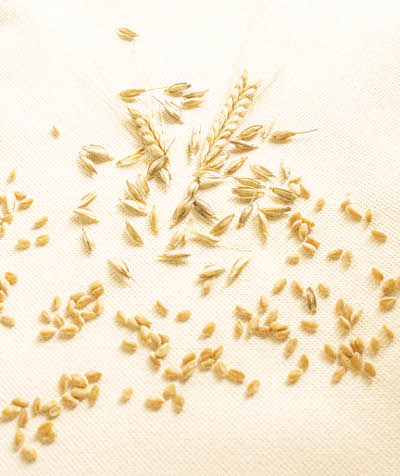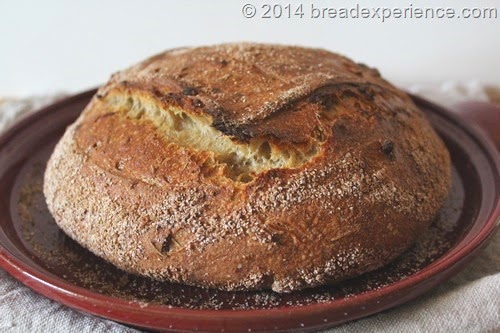Have you heard about Einkorn? It’s an ancient grain that’s been making a comeback in recent years due to its nutritional value.
If you want to learn how to bake bread with this fascinating grain, then come along with me on a journey to discover more about the grain of the ancients.
Seed Heads and Wheat Berries

I started experimenting with Einkorn in early 2011. One of the main reasons I became interested in this wheat is that it can sometimes be tolerated by those with wheat sensitivities.
I love history, especially the history of wheat, so along the way, I’ve become enamored with ancient grains, especially Einkorn. My journey has taken me into areas I would never have imagined I would go. I traveled to Tuscany, one of the places where this wheat is grown, to find out more about baking with it. I’ve also attended workshops in the States to learn more about this nutty grain. Although I enjoy working with other grains, Einkorn has become one of my favorites.
What is Einkorn?
Einkorn is from the species Triticum monococcum. Originally from the Fertile Crescent area, it is thought to be the first wheat cultivated by man over 12,000 years ago. It moved from the Fertile Crescent area to Eastern Europe and eventually to the Italian Alps where it was found in 1991 with the frozen remains of Ötzi the Iceman. They examined his last meal and it contained meat, roots, berries, and einkorn wheat.
This grain has been making a comeback because of its high protein content and the fact that it grows easily on minimal amounts of land and in adverse conditions. After all of these centuries, it has remained a pure wheat. It’s the only wheat that has not been hybridized. It has 14 chromosomes compared to 42 chromosomes in modern wheat.
Like other varieties of ancient wheat, it is hulled, which means it has a protective layer that stays intact when it is harvested. The protective layer has to be removed before milling which requires an extra step and additional time. As a result, the yield for this type of wheat is lower than the yield for modern wheat.

Einkorn & Spelt Pain au Levain with Caramelized Onions
How does it compare to modern wheat?
Breads made with this ancient grain are light and creamy in color and have a rich flavor similar to whole wheat flour, but not as bitter.
Since Einkorn’s gluten structure has not been altered over the years, it is more easily digestible than modern wheat, but this makes it a little trickier to bake with. Dough made with this flour is very extensible, but because the gluten is weaker, it requires a shorter mixing and kneading cycle than with regular bread flour.
Slight adjustments to the hydration level (flour-to-water ratio) and the amount of yeast are also necessary when baking bread with this wheat. As a general rule, the hydration amount should be reduced by 20% for bread made with all-purpose einkorn and about 15% for whole wheat einkorn flour.
This ancient wheat is also very nutritious. It contains higher levels of protein (22.83% vs. modern hard red wheat-14.5%), essential fatty acids, phosphorous, potassium, riboflavin, pyridoxine (B6), lutein and beta-carotene (lutein) than modern wheat.
Where can you find this ancient grain?
Jovial Foods is one of the largest growers of Einkorn. They currently grow their wheat in Tuscany although plans are underway to expand to the U.S. You’ll find all-purpose flour, whole wheat flour, sprouted wheat flour, whole grain berries, and pasta products on their website.
You can also find information about this ancient grain on Einkorn.com. They started the Einkorn movement in the U.S. and are based out of Idaho. They work with a network of growers in the U.S. On their site, you’ll find organic all-purpose Einkorn flour, and Einkorn berries if you prefer to mill your flour.
What types of bread can be made with it?
Here are some of the breads I’ve made using this ancient wheat.
Note: Not all of the breads I’ve made are listed here so to find more breads, just type “Einkorn” into the search box at the top and you’ll be presented with more options. And please do check back to discover more breads as I continue baking with ancient grains.
Ancient Grain Tartine
Includes Spelt and KAMUT.
Bread made with an overnight sponge
Basic whole wheat bread using freshly milled flour and an overnight sponge.
Cape Seed bread in a Lekue Baker
Bread chock full of seeds and nutrition.
Classic Sandwich Bread
Sandwich loaf made with all-purpose Einkorn flour.
Einkorn & Spelt Sourdough
With Caramelized Onions & Rosemary baked in a ceramic bread baker.
Levain with an overnight poolish
Whole Wheat Bread made with an overnight poolish.
Normandy Apple Bread
Sourdough bread made with dried apples, apple cider, bread flour and ancient grain flour.
Oatmeal Bread Machine Bread
A delicious Oatmeal Bread machine bread made with a mixture of flours and steel cut oats.
Old-Style Pumpernickel
Made in a Pullman pan using stale Einkorn bread.
Pizza Dough
Whole grain pizza crust made with the grain of the ancients.
Pumpkin Bread
Quick bread made with olive oil and ancient whole wheat flour.
Pumpkin Yeast Bread
This Pumpkin Yeast Bread is made with 80% extraction Einkorn flour.
Roasted Garlic & Potato Bread
Made with Einkorn.
Sesame Einkorn Crackers
Whole grain crackers with sesame seeds.
Scones
Chocolate chip scones with Spelt and Einkorn.
Soda Crackers
Homemade herb soda crackers
Sourdough Bread
Sourdough bread made with an Einkorn sourdough starter and flour.
Sourdough Banana Bread
Banana bread made with a sourdough starter as the leavening.
Sourdough Crackers
With einkorn & barley flours.
Sourdough Multigrain Bread
With ancient grains and an overnight soaker.
Sourdough Starter
Developing a sourdough starter using ancient wheat flour.
Spelt & Einkorn Party Brot
Brown and white rolls with poppy seeds and spelt flakes.
Sprouted Einkorn Bread
A delicious sprouted bread made with sprouted grains and all-purpose flour.
Sprouted Bread with no Flour
One of the keys to success with this sprouted bread is to only let the grains sprout until the tiny sprouts are just barely beginning to show.
Sources:
www.einkorn.com/types-of-wheat-nutritional-content-health-benefits-comparison
www.growseed.org/einkorn.html
www.jovialfoods.com
www.naturalnews.com/032260_Einkorn_wheat.html
Homegrown Whole Grains by Sara Pitzer

Do know if Einkorn can be sprouted?
Hi, Yes, einkorn can be sprouted. I have made bread with sprouted einkorn.
Hello I am going to try the einkorn sourdough starter, in the directions it says ” keeping your starter going: place the remaining starter in quart jar and put in the refrigerator to use as your new einkorn starter. After you have created the starter keep it going to use in other breads? It does not say how to keep it going, how often to feed it, etc..
Please advise. Thank you
Hello Jane, that’s a good question. I usually use the method outlined in this post when I feed my starters https://www.breadexperience.com/activating-sourdough-culturestarter/. However, if you prefer, you can discard about half (or a portion depending on how much you have) and feed it with 1/3 cup of einkorn flour and enough water to make a thick pancake-like batter. Happy Baking!
You mention that the hydration should be decreased by 20%. How much do you reduce the yeast? Also there a limit on how much einkorn flour can be substituted for bread flour?
Hi Mike, the hydration % is for all-purpose einkorn and it could differ based on humidity and other factors in your kitchen. If you are using whole grain einkorn, you’ll need to increase the hydration by about 5% because it will be too dry otherwise. As far as the amount of yeast, the basic rule of thumb is to let einkorn dough rise by half. I typically cut the yeast by 1/4 to 1/2 to start with and let it ferment longer. However, if you watch the dough closely and let it ferment slower, you may not need to reduce the yeast. Working with einkorn is different than working with regular bread flour. There isn’t a limit on how much einkorn flour can be substituted for bread flour. You can use all AP einkorn flour instead of bread flour; just know that it will be a softer dough. And, if you overmix it, it will be stickier than bread flour. It’s a beautiful dough to work with so it’s worth experimenting with.
Do you have a Challah recipe using whole grain Einkorn flour. I have the wheat berries and grind my own flour but I am relatively new to using Einkorn wheat and am not used to making yeast breads with this flour.
Hi Nicole,
I have a braided bread recipe that uses all-purpose einkorn, but I haven’t tried it with whole grain einkorn yet. Here is the recipe https://www.breadexperience.com/braided-einkorn-olive-oil-loaf/ You could substitute whole grain einkorn, but it will be a denser loaf. The main thing about working with einkorn is to reduce the hydration (if you are using a recipe that is made for regular bread flour) and allow for a longer fermentation time to develop the structure of the dough. Einkorn has a weaker protein so it’s a softer dough and needs to be handled more gently. Hope this helps.
Happy Baking!
Cathy
I recently been making einkorn bread and am not sure what is the right consistency that the dough should be. I just add enough water and mix until the dough is relatively sticky. Then I let it sit with something covering the bowl for around 40 min or until it has rise.
The problem is, when it’s finally baked, it is dry. It’s not dry when it’s fresh out of the oven but when it’s cool. It’s not moist and I’m not sure if it’s not enough water, oil, butter or what. How do you make einkorn moist and soft without crumbling or falling apart?
Hi Theresa, what type of bread are you making with the einkorn and what type of flour – all-purpose or whole grain einkorn are you using? Whole grain absorbs more hydration than the all-purpose. It will also depend on the type of einkorn you are using. I did a comparison of a few different types of einkorn. The absorption was a little different between the three types. You might find this post helpful https://www.breadexperience.com/making-sourdough-einkorn-loaves/
Hi Cathy,
I use Jovial all purpose einkorn. I use this artisan recipe I’ve found on YouTube but instead of making artisan, I just pour the dough into a bread pan. Maybe that had something to do with the texture of the bread…
I also read the link you posted in your reply. It’s interesting about the different hydration amount. Thus far, I’ve only use jovial. It won’t be a while until I use any other brand.
It is a little bit different working with einkorn. Since I’m not familiar with the bread you tried, I really couldn’t say why it turned out dry, but keep experimenting and you’ll get the hang of it.
Alrighty then. I’ll surely continue experimenting. Thanks for replying to my messages and have a great day 😀